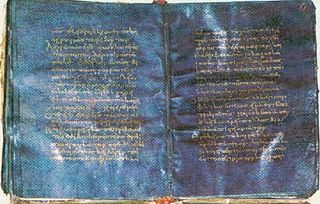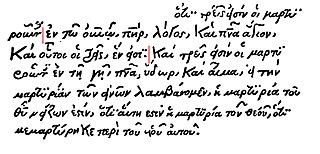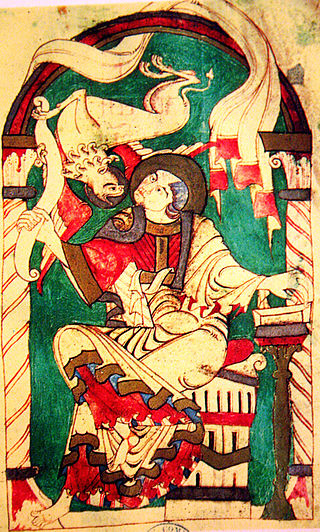The Codex Palatinus, designated by e or 2 (in Beuron system), is a 5th-century Latin Gospel Book. The text, written on purple dyed vellum in gold and silver ink (as are codices a b f i j ), is a version of the old Latin. Most of the manuscript was in the Austrian National Library at Vienna (Cod. 1185) until 1919, when it was transferred to Trento, where it is now being kept as Ms 1589 in the Library of Buonconsiglio Castle. [1] Two leaves were separated from the manuscript in the 18th century: one is now in the library of Trinity College, Dublin (MS 1709), the other in the British Library (Add. MS 40107) in London (Digital images). [2]
The manuscript contains the text of the four Gospels. The Gospels follow in the Western order. [2]
The Latin text of the codex is basically African recension, but it has been strongly Europeanized. [4]
In John 1:34 it reflects ὁ ἐκλεκτός along with the manuscripts 𝔓5, 𝔓106, א, b, ff2, syrc, syrs. [5]
The manuscript was acquired from Trent between 1800 and 1829. [3] It was edited by Constantin von Tischendorf (Evangelicum Palatinum ineditum, Leipzig 1847), Johannes Belsheim, and Jülicher. [2] [6]

There have been many Coptic versions of the Bible, including some of the earliest translations into any language. Several different versions were made in the ancient world, with different editions of the Old and New Testament in five of the dialects of Coptic: Bohairic (northern), Fayyumic, Sahidic (southern), Akhmimic and Mesokemic (middle). Biblical books were translated from the Alexandrian Greek version.
Codex Colbertinus, designated by 6 or c, is a Latin manuscript of the Bible. Its version of the four Gospels and Book of Acts follows the Vetus Latina, while the rest of the New Testament follows the Vulgate. It was written in the 11th or 12th century, probably in southern France.

The Codex Petropolitanus Purpureus, designated by N or 022, ε19, is a Greek New Testament codex containing the four Gospels written on parchment. Using the study of comparative writing styles (palaeography), it has been assigned to the 6th century CE.
The Garland of Howth, also known as the Codex Usserianus Secundus, designated by r2 or 28, is a fragmentary 8th to 10th century Latin Gospel Book now in Trinity College Dublin as MS. 56.

Minuscule 565, ε 93, also known as the Empress Theodora's Codex, is a Greek minuscule manuscript of the New Testament, written on purple parchment. Using the study of comparative writing styles (palaeography), it has been assigned to the 9th century. It was labelled by Biblical scholar Frederick H. A. Scrivener as 473. The manuscript has several gaps. It has marginalia.

Codex Montfortianus designated by 61, δ 603, and known as Minuscule 61 is a Greek minuscule manuscript of the New Testament on paper. Erasmus named it Codex Britannicus. Its completion is dated on the basis of its textual affinities to no earlier than the second decade of the 16th century, though a 15th-century date is possible on palaeographic grounds. The manuscript is famous for including a unique version of the Comma Johanneum. It has marginalia.
The Codex Vindobonensis Lat. 1235, designated by i or 17, is a 6th-century Latin Gospel Book. The manuscript contains 142 folios. The text, written on purple dyed vellum in silver ink, is a version of the old Latin. The Gospels follow in the Western order.

The Codex Veronensis, designated by siglum b or 4, is a 5th-century Latin Gospel Book. The text, written on purple dyed vellum in silver and occasionally gold ink, is a version of the old Latin. The Gospels follow in the Western order.

The Codex Corbeiensis I, designated by ff1 or 9, is an 8th, 9th, or 10th-century Latin New Testament manuscript. The text, written on vellum, is a version of the old Latin. The manuscript contains 39 parchment folios with the text of the four Gospels, Acts of the Apostles, and General epistles.
The Codex Corbeiensis II, designated by ff2 or 8, is a 5th-century Latin Gospel Book. The text, written on vellum, is a version of the old Latin. The manuscript contains 190 parchment folio with the text of the four Gospels with lacunae. Written in a beautiful round uncial hand.
The Codex Sarzanensis, or Codex Saretianus, designated by j or 22, is a 5th or 6th century Latin Gospel Book. The text, written on purple dyed vellum in silver ink, is a version of the old Latin.
The Codex Curiensis known also as Fragmenta Curiensia, designated by a2 or 16, is a 5th-century AD Latin manuscript of the New Testament. The text, written on vellum, is a version of the old Latin. The manuscript contains the fragments of the Gospel of Luke, on exactly two parchment leaves.
The Codex Curinthianus, designated by β or 26, is a 6th or 7th century Latin manuscript of the New Testament. The text, written on vellum, is a version of the old Latin. The manuscript contains the fragments of the Gospel of Luke, on only 2 parchment leaves.
The Codex Mediolanensis or Fragmentum Mediolanense, designated by g2 or 52, is a 10th- or 11th-century Latin manuscript of the New Testament. The text, written on vellum, is a version of the Vetus Latina. The manuscript contains the fragments of the Gospel of Luke, on only 2 parchment leaves. It was a lectionary.
The Codex Sangermanensis I, designated by g1 or 7, is a Latin manuscript, dated AD 822 of portions of the Old Testament and the New Testament. The text, written on vellum, is a version of the Latin. The manuscript contains the Vulgate Bible, on 191 leaves of which, in the New Testament, the Gospel of Matthew contain Old Latin readings. It contains Shepherd of Hermas.
British Library, Add MS 14459, Syriac manuscript of the New Testament, on a parchment. It is dated by a colophon to the year 528-529 or 537-538. It is one of the oldest manuscript of Peshitta and the earliest dated manuscript containing two of the Gospels in Syriac. The manuscript is bound with another dated to the 5th century.
The Codex Bernensis known also as Fragmenta Bernensia, designated by t or 19, is a 5th or 6th century Latin manuscript of the New Testament. The text, written on vellum, is a version of the old Latin. The manuscript contains the fragments of the Gospel of Mark, on only 2 parchment leaves. Written in two columns per page, 23 lines per column. It is a palimpsest.

The Codex Claromontanus V, designated by h in traditional system or by 12 in the Beuron system, is a 4th- or 5th-century Latin manuscript of the New Testament. The text, written on vellum.
The Codex Floriacensis, designated by h in traditional system or by 55 in the Beuron system, is a 6th-century Latin manuscript of the New Testament. The text, written on vellum, is a palimpsest. Another name of the manuscript is Fleury Palimpsest or Palimpsestus Floriacensis. It is one of the eight Old-Latin manuscripts with text of Apocalypse.
The Codex Gatianum, designated by gat or 30, is an 8th-century Latin manuscript of the New Testament. The text, written on vellum, is a version of the Old Latin.
{{cite book}}: CS1 maint: location missing publisher (link)